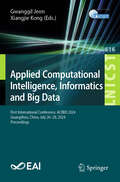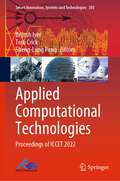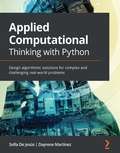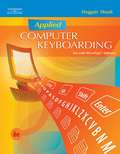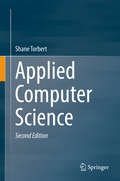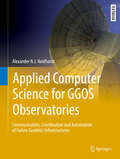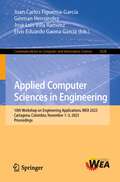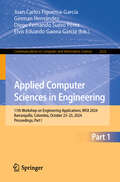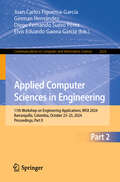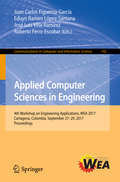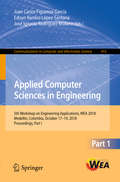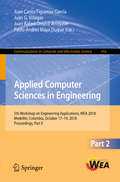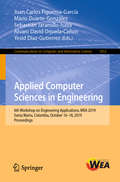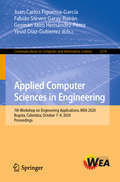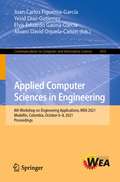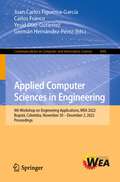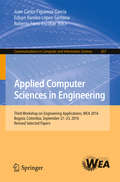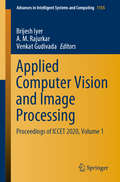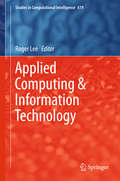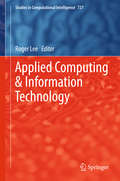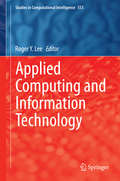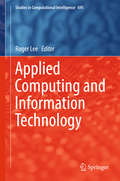- Table View
- List View
Applied Computational Intelligence and Mathematical Methods: Computational Methods in Systems and Software 2017, vol. 2 (Advances in Intelligent Systems and Computing #662)
by Radek Silhavy Petr Silhavy Zdenka ProkopovaThe book discusses real-world problems and exploratory research in computational intelligence and mathematical models. It brings new approaches and methods to real-world problems and exploratory research that describes novel approaches in the mathematical methods, computational intelligence methods and software engineering in the scope of the intelligent systems. This book constitutes the refereed proceedings of the Computational Methods in Systems and Software 2017, a conference that provided an international forum for the discussion of the latest high-quality research results in all areas related to computational methods, statistics, cybernetics and software engineering.
Applied Computational Intelligence, Informatics and Big Data: First International Conference, ACIIBD 2024, Guangzhou, China, July 26–28, 2024, Proceedings (Lecture Notes of the Institute for Computer Sciences, Social Informatics and Telecommunications Engineering #616)
by Gwanggil Jeon Xiangjie KongThis book LNICST 616 constitutes the proceedings of the First International Conference on Applied Computational Intelligence, Informatics and Big Data, ACIIBD 2024, held in Guangzhou, China, during July 26–28, 2024. The 3 full papers and 15 shot papers were carefully reviewed and selected from 56 submissions. This Proceedings cover topics on Internet of Things, Information Communication Technology, Edge Computing, Mobile Computing, Neural Network, Intelligent Control System, Real-Time Information System, Intelligent Perception and many other cutting-edge fields and disciplines.
Applied Computational Mathematics: ICCE 2023, Chennai, India, December 8-9 (Springer Proceedings in Mathematics & Statistics #480)
by Indra Rajasingh Sharmila Mary Arul Diana Grace ThomasThis proceedings volume showcases high-quality original research papers presented at the International Conference on Computational Engineering (ICCE 2023), held in Chennai, India, from December 8-9, 2023 dedicated to advancing interdisciplinary research in the realm of mathematics and its pivotal role in Computer Engineering. Explore the dynamic field of Computational Engineering, where innovative computational techniques—such as computer simulations, mathematical modeling, and numerical analysis—are employed to tackle complex engineering challenges. By integrating principles from engineering, computer science, and applied mathematics, this collection illustrates how virtual prototypes enable engineers to analyze and optimize systems before physical testing, saving valuable time and resources. Featuring selected works from conference participants and outstanding contributions from external researchers, this book highlights the broad applications of Computational Engineering across civil, mechanical, aerospace, chemical, electrical engineering, and beyond. Dive into cutting-edge research that paves the way for future advancements in engineering practices.
Applied Computational Technologies: Proceedings of ICCET 2022 (Smart Innovation, Systems and Technologies #303)
by Sheng-Lung Peng Brijesh Iyer Tom CrickThis book is a collection of best selected research papers presented at 7th International Conference on Computing in Engineering and Technology (ICCET 2022), organized by Dr. Babasaheb Ambedkar Technological University, Lonere, India, during February 12 – 13, 2022. Focusing on frontier topics and next-generation technologies, it presents original and innovative research from academics, scientists, students, and engineers alike. The theme of the conference is Applied Information Processing System.
Applied Computational Thinking with Python: Design algorithmic solutions for complex and challenging real-world problems
by Sofia De Jesus Dayrene MartinezUse the computational thinking philosophy to solve complex problems by designing appropriate algorithms to produce optimal results across various domainsKey FeaturesDevelop logical reasoning and problem-solving skills that will help you tackle complex problemsExplore core computer science concepts and important computational thinking elements using practical examplesFind out how to identify the best-suited algorithmic solution for your problemBook DescriptionComputational thinking helps you to develop logical processing and algorithmic thinking while solving real-world problems across a wide range of domains. It's an essential skill that you should possess to keep ahead of the curve in this modern era of information technology. Developers can apply their knowledge of computational thinking to solve problems in multiple areas, including economics, mathematics, and artificial intelligence.This book begins by helping you get to grips with decomposition, pattern recognition, pattern generalization and abstraction, and algorithm design, along with teaching you how to apply these elements practically while designing solutions for challenging problems. You'll then learn about various techniques involved in problem analysis, logical reasoning, algorithm design, clusters and classification, data analysis, and modeling, and understand how computational thinking elements can be used together with these aspects to design solutions. Toward the end, you will discover how to identify pitfalls in the solution design process and how to choose the right functionalities to create the best possible algorithmic solutions.By the end of this algorithm book, you will have gained the confidence to successfully apply computational thinking techniques to software development.What you will learnFind out how to use decomposition to solve problems through visual representationEmploy pattern generalization and abstraction to design solutionsBuild analytical skills required to assess algorithmic solutionsUse computational thinking with Python for statistical analysisUnderstand the input and output needs for designing algorithmic solutionsUse computational thinking to solve data processing problemsIdentify errors in logical processing to refine your solution designApply computational thinking in various domains, such as cryptography, economics, and machine learningWho this book is forThis book is for students, developers, and professionals looking to develop problem-solving skills and tactics involved in writing or debugging software programs and applications. Familiarity with Python programming is required.
Applied Computer Keyboarding: Use with MicroType Software
by Jack P. Hoggatt Jon A. ShankLooking for a keyboarding book without all the extra applications? APPLIED COMPUTER KEYBOARDING 6E is a one-semester new-key-learning text with basic word processing and document formatting. Computer keyboarding is emphasized as touch typing is learned and business-correct documents needed for every workplace are produced. This revised edition includes new cross-curricular activities and is written to support and align with the new-key instruction and word processing features in South-Western's MicroType keyboarding software.
Applied Computer Science
by Shane TorbertThe second edition of this introductory text includes an expanded treatment of collisions, agent-based models, and insight into underlying system dynamics. Lab assignments are accessible and carefully sequenced for maximum impact. Students are able to write their own code in building solutions and Python is used to minimize any language barrier for beginners. Problems involving visualization are emphasized throughout with interactive graphics, image files, and plots of generated data. This text aims to establish a core learning experience around which any number of other learning objectives could be included. The text is presented in eight chapters where each chapter contains three problems and each problem develops five specific lab assignments, plus additional questions and discussion. This approach seeks to leverage the immediate feedback provided by the computer to help students as they work toward writing code creatively. All labs will scale to available hardware and free software could be used for the entire course, if desired. Lab assignments have been used since 2011 at the #1 ranked U. S. high school. It is an ideal textbook for high school courses that prepare students for advanced placement tests.
Applied Computer Science for GGOS Observatories: Communication, Coordination and Automation of Future Geodetic Infrastructures (Springer Textbooks in Earth Sciences, Geography and Environment)
by Alexander NeidhardtThis book combines elementary theory from computer science with real challenges in global geodetic observation, based on examples from the Geodetic Observatory Wettzell, Germany. It starts with a step-by-step introduction for developing stable and safe scientific software. It continues with a network middleware for distributed systems using generative programming. A main focus of the book is the strategy and realization of autonomous production cells for space geodetic techniques. A satellite laser ranging system is shown as an example for this. These automated systems are combined for global interaction, and for coordinated multi-agent systems using secure tunnels on the example of radio telescopes.
Applied Computer Sciences in Engineering: 10th Workshop on Engineering Applications, WEA 2023, Cartagena, Colombia, November 1–3, 2023, Proceedings (Communications in Computer and Information Science #1928)
by Juan Carlos Figueroa-García German Hernández Jose Luis Villa Ramirez Elvis Eduardo Gaona GarcíaThis book constitutes the refereed proceedings of the 10th Workshop on Engineering Applications, WEA 2023, held in Cartagena, Colombia, during November 1–3, 2023. The 37 full papers included in this book were carefully reviewed and selected from 93 submissions. They were organized in topical sections as follows: artificial intelligence; optimization; and simulation.
Applied Computer Sciences in Engineering: 11th Workshop on Engineering Applications, WEA 2024, Barranquilla, Colombia, October 23–25, 2024, Proceedings, Part I (Communications in Computer and Information Science #2222)
by Juan Carlos Figueroa-García German Hernández Elvis Eduardo Gaona García Diego Fernando Suero PérezThe two-volume set CCIS 2222 + 2223 constitutes the proceedings of the 11th Workshop on Engineering Applications, WEA 2024, which took place in Barranquilla, Colombia, during October 23–25, 2024. The 42 full papers presented here were carefully reviewed and selected from 97 submissions. The papers are organized in the following topical sections: Part I - Artificial Intelligence. Part II - Optimization; Simulation; Applications.
Applied Computer Sciences in Engineering: 11th Workshop on Engineering Applications, WEA 2024, Barranquilla, Colombia, October 23–25, 2024, Proceedings, Part II (Communications in Computer and Information Science #2223)
by Juan Carlos Figueroa-García German Hernández Elvis Eduardo Gaona García Diego Fernando Suero PérezThe two-volume set CCIS 2222 and 2223 constitutes the proceedings of the 11th Workshop on Engineering Applications, WEA 2024, which took place in Barranquilla, Colombia, during October 23–25, 2024. The 42 full papers presented here were carefully reviewed and selected from 97 submissions. The papers are organized in the following topical sections: Part I - Artificial Intelligence. Part II - Optimization; Simulation; Applications.
Applied Computer Sciences in Engineering: 4th Workshop on Engineering Applications, WEA 2017, Cartagena, Colombia, September 27-29, 2017, Proceedings (Communications in Computer and Information Science #742)
by Juan Carlos Figueroa-García Eduyn Ramiro López-Santana Roberto Ferro-Escobar José Luis Villa-RamírezThis book constitutes the refereed proceedings of the Forth Workshop on Engineering Applications, WEA 2017, held in Cartagena, Colombia, in September 2017. The 59 revised full papers presented were carefully reviewed and selected from156 submissions. The papers are organized in topical sections such as computer science; computational intelligence; simulation systems; internet of things; fuzzy sets and systems; power systems; logistics and operations management; miscellaneous applications.
Applied Computer Sciences in Engineering: 5th Workshop on Engineering Applications, WEA 2018, Medellín, Colombia, October 17-19, 2018, Proceedings, Part I (Communications in Computer and Information Science #915)
by Juan Carlos Figueroa-García Eduyn Ramiro López-Santana José Ignacio Rodriguez-MolanoThis two-volume set (CCIS 915 and CCIS 916) constitutes the refereed proceedings of the 5th Workshop on Engineering Applications, WEA 2018, held in Medellín, Colombia, in October 2018. The 50 revised full papers presented in this volume were carefully reviewed and selected from126 submissions. The papers are organized in topical sections such as computer science; computational intelligence; simulation systems; software engineering; power and energy applications.
Applied Computer Sciences in Engineering: 5th Workshop on Engineering Applications, WEA 2018, Medellín, Colombia, October 17-19, 2018, Proceedings, Part II (Communications in Computer and Information Science #916)
by Juan Carlos Figueroa-García Juan G. Villegas Juan Rafael Orozco-Arroyave Pablo Andres Maya DuqueThis two-volume set (CCIS 915 and CCIS 916) constitutes the refereed proceedings of the 5th Workshop on Engineering Applications, WEA 2018, held in Medellín, Colombia, in October 2018. The 41 revised full papers presented in this volume were carefully reviewed and selected from 101 submissions. The papers are organized in topical sections such as green logistics and optimization, Internet of Things (IoT), digital signal processing (DSP), network applications, miscellaneous applications.
Applied Computer Sciences in Engineering: 6th Workshop on Engineering Applications, WEA 2019, Santa Marta, Colombia, October 16–18, 2019, Proceedings (Communications in Computer and Information Science #1052)
by Juan Carlos Figueroa-García Mario Duarte-González Sebastián Jaramillo-Isaza Alvaro David Orjuela-Cañon Yesid Díaz-GutierrezThis volume constitutes the refereed proceedings of the 6th Workshop on Engineering Applications, WEA 2019, held in Santa Marta, Colombia, in October 2019.The 62 revised full papers and 2 short papers presented in this volume were carefully reviewed and selected from 178 submissions. The papers are organized in the following topical sections: computer science; computational intelligence; bioengineering; Internet of things; power applications; simulation systems; optimization.
Applied Computer Sciences in Engineering: 7th Workshop on Engineering Applications, WEA 2020, Bogota, Colombia, October 7–9, 2020, Proceedings (Communications in Computer and Information Science #1274)
by Juan Carlos Figueroa-García Yesid Díaz-Gutierrez Fabián Steven Garay-Rairán Germán Jairo Hernández-PérezThis volume constitutes the refereed proceedings of the 7th Workshop on Engineering Applications, WEA 2020, held in Bogota, Colombia, in October 2020.The 32 revised full papers and 12 short papers presented in this volume were carefully reviewed and selected from 136 submissions. The papers are organized in the following topical sections: computational intelligence; computer science; optimization; bioengineering; military applications; simulation, IoT and networks; power applications.
Applied Computer Sciences in Engineering: 8th Workshop on Engineering Applications, WEA 2021, Medellín, Colombia, October 6–8, 2021, Proceedings (Communications in Computer and Information Science #1431)
by Juan Carlos Figueroa-García Alvaro David Orjuela-Cañón Yesid Díaz-Gutierrez Elvis Eduardo Gaona-GarcíaThis volume constitutes the refereed proceedings of the 8th Workshop on Engineering Applications, WEA 2021, held in Medellín, Colombia, in October 2021. Due to the COVID-19 pandemic the conference was held in a hybrid mode. The 33 revised full papers and 11 short papers presented in this volume were carefully reviewed and selected from 127 submissions. The papers are organized in the following topical sections: computational intelligence; bioengineering; Internet of Things (IoT); optimization and operations research; engineering applications.
Applied Computer Sciences in Engineering: 9th Workshop on Engineering Applications, WEA 2022, Bogotá, Colombia, November 30 – December 2, 2022, Proceedings (Communications in Computer and Information Science #1685)
by Juan Carlos Figueroa-García Yesid Díaz-Gutierrez Carlos Franco Germán Hernández-PérezThis book constitutes the proceedings of the 9th Workshop on Engineering Applications on Applied Computer Sciences in Engineering, WEA 2022, which took place in Bogotá, Colombia, in November/December 2022. The 39 papers presented in this volume were carefully reviewed and selected from 143 submissions. They were organized in topical sections as follows: Artificial Intelligence; Optimization; Simulation; and Applications.
Applied Computer Sciences in Engineering: Third Workshop on Engineering Applications, WEA 2016, Bogotá, Colombia, September 21-23, 2016, Revised Selected Papers (Communications in Computer and Information Science #657)
by Juan Carlos Figueroa-García Eduyn Ramiro López-Santana Roberto Ferro-EscobarThis book constitutes the refereed proceedings of the Third Workshop on Engineering Applications, WEA 2016, held in Bogot#65533;, Colombia, in September 2016. The 35 revised full papers presented were carefully reviewed and selected from 128 submissions. The papers are organized in topical sections on computer science; computational intelligence; simulation systems; fuzzy sets and systems; power systems; miscellaneous applications.
Applied Computer Vision and Image Processing: Proceedings of ICCET 2020, Volume 1 (Advances in Intelligent Systems and Computing #1155)
by Brijesh Iyer A. M. Rajurkar Venkat GudivadaThis book gathers high-quality research papers presented at the International Conference on Computing in Engineering and Technology (ICCET 2020) [formerly ICCASP]. A flagship conference on engineering and emerging next-generation technologies, it was jointly organized by Dr. Babasaheb Ambedkar Technological University and MGMs College of Engineering, Nanded, India on 9–11 January 2020. Focusing on applied computer vision and image processing, this proceedings volume includes papers on image processing, computer vision, pattern recognition, and DSP/DIP applications in healthcare systems.
Applied Computer Vision and Soft Computing with Interpretable AI
by Oscar Castillo Swati V. Shinde Darshan V. MedhaneThis reference text presents the knowledge base of computer vision and soft computing techniques with their applications for sustainable developments. Features: Covers a variety of deep learning architectures useful for computer vision tasks Demonstrates the use of different soft computing techniques and their applications for different computer vision tasks Highlights the unified strengths of hybrid techniques based on deep learning and soft computing taken together that give the interpretable, adaptive, and optimized solution to a given problem Addresses the different issues and further research opportunities in computer vision and soft computing Describes all the concepts with practical examples and case studies with appropriate performance measures that validate the applicability of the respective technique to a certain domain Considers recent real word problems and the prospective solutions to these problems This book will be useful to researchers, students, faculty, and industry personnel who are eager to explore the power of deep learning and soft computing for different computer vision tasks.
Applied Computing & Information Technology (Studies in Computational Intelligence #619)
by Roger LeeThis edited book presents scientific results of the 3nd International Conference on Applied Computing and Information Technology (ACIT 2015) which was held on July 12-16, 2015 in Okayama, Japan. The aim of this conference was to bring together researchers and scientists, businessmen and entrepreneurs, teachers, engineers, computer users, and students to discuss the numerous fields of computer science and to share their experiences and exchange new ideas and information in a meaningful way. Research results about all aspects (theory, applications and tools) of computer and information science, and to discuss the practical challenges encountered along the way and the solutions adopted to solve them.
Applied Computing & Information Technology (Studies in Computational Intelligence #727)
by Roger LeeThis edited book presents scientific results of the 4th International Conference on Applied Computing and Information Technology (ACIT 2016) which was held on December 12-14, 2016 in Las Vegas, USA. The aim of this conference was to bring together researchers and scientists, businessmen and entrepreneurs, teachers, engineers, computer users, and students to discuss the numerous fields of computer science and to share their experiences and exchange new ideas and information in a meaningful way. The aim of this conference was also to bring out the research results about all aspects (theory, applications and tools) of computer and information science, and to discuss the practical challenges encountered along the way and the solutions adopted to solve them. The conference organizers selected the best papers from those papers accepted for presentation at the conference. The papers were chosen based on review scores submitted by members of the Program Committee, and underwent further rigorous rounds of review. This book captures 11 of the conference's most promising papers, and the readers impatiently await the important contributions that they know these authors are going to bring to the field of computer and information science.
Applied Computing and Information Technology (Studies in Computational Intelligence #553)
by Roger Y. LeeThis book presents the selected results of the 1st International Symposium on Applied Computers and Information Technology (ACIT 2013) held on August 31 - September 4, 2013 in Matsue City, Japan, which brought together researchers, scientists, engineers, industry practitioners and students to discuss all aspects of Applied Computers & Information Technology and its practical challenges. This book includes the best 12 papers presented at the conference, which were chosen based on review scores submitted by members of the program committee and underwent further rigorous rounds of review.
Applied Computing and Information Technology (Studies in Computational Intelligence #695)
by Roger LeeThis book presents the selected results of the 1st International Symposium on Applied Computers and Information Technology (ACIT 2013) held on August 31 - September 4, 2013 in Matsue City, Japan, which brought together researchers, scientists, engineers, industry practitioners and students to discuss all aspects of Applied Computers & Information Technology and its practical challenges. This book includes the best 12 papers presented at the conference, which were chosen based on review scores submitted by members of the program committee and underwent further rigorous rounds of review.

